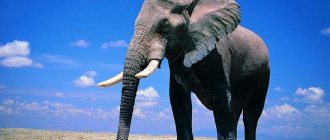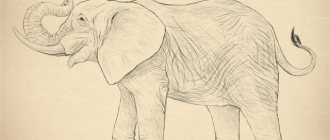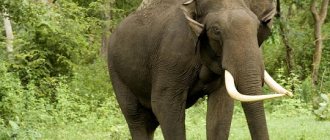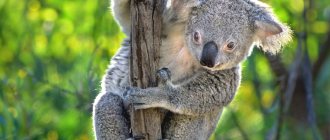- Wild animals
- >>
- Mammals
Today, the African elephant is the largest mammal in the world that lives on land, and the second largest among all animals living on earth.
The championship was given to the blue whale. On the territory of the African continent, the elephant is the only representative of the proboscis family. Amazing strength, power and behavioral characteristics have always aroused special interest, delight and admiration among people. Looking at an elephant, one gets the impression that it is overweight, clumsy, and sometimes even lazy. However, this is not at all true. Despite their size, elephants can be very agile, fast and agile.
Origin of the species and description
Photo: African elephant
The African elephant is a chordate mammal. It is a representative of the proboscis order and the elephant family, a genus of African elephants. African elephants, in turn, are divided into two more subspecies: forest and savanna. As a result of numerous examinations, the estimated age of the mammal’s existence on earth has been established. It is almost five million years old. Zoologists claim that the ancient ancestors of the African elephant led a predominantly aquatic lifestyle. The main source of nutrition was aquatic vegetation.
The ancestor of the African elephant is called Meriteria. Presumably it existed on earth more than 55 million years ago. His remains were discovered in the territory of modern Egypt. It was small in size. Corresponded to the body size of a modern wild boar. Meryterium had short but well-developed jaws and a small trunk. The trunk was formed as a result of the fusion of the nose and upper lip in order to easily move through the water space. Outwardly, he looked like a small hippopotamus. Merytherium gave rise to a new genus - paleomastodon.
Video: African elephant
His time was in the Upper Eocene. This is evidenced by archaeological finds on the territory of modern Egypt. Its size was much larger than the size of the meretherium's body, and its trunk was much longer. The paleomastodon became the ancestor of the mastodon, which in turn became the ancestor of the mammoth. The last mammoths existing on earth were on Wrangel Island and were exterminated about 3.5 thousand years ago.
Zoologists claim that about 160 species of proboscis have become extinct on earth. Among these species there were animals of incredible size. The weight of some representatives of certain species exceeded 20 tons. Today, elephants are considered quite rare animals. There are only two species left on earth: African and Indian.
Appearance and features
Photo: Animal African elephant
The African elephant is truly enormous in size. It is much larger than the Indian elephant. The animal reaches a height of 4-5 meters, and its weight is about 6-7 tons. They have pronounced sexual dimorphism. Female individuals are significantly inferior in size and body weight. The largest representative of this species of elephant reached a height of approximately 7 meters, and its weight was 12 tons.
African giants are distinguished by very long, huge ears. Their size is approximately one and a half to two times the size of the ears of an Indian elephant. Elephants tend to escape from overheating by flapping their huge ears. Their length can reach two meters. Thus, they lower their body temperature.
The huge animals have a massive, large body and a very small tail, just over a meter long. The animals have a large, massive head and a short neck. Elephants have powerful, thick limbs. They have a peculiarity in the structure of their soles, thanks to which they easily move both on sand and on flat terrain. The area of the feet may increase or decrease when walking. The forelimbs have four fingers, the hind limbs have three.
Among African elephants, just like among people, there are left-handers and right-handers. This is determined depending on which tusk the elephant uses most often. The skin of the animal is dark gray in color and covered with sparse hair. She is wrinkled and rough. However, the skin is very sensitive to external factors. They are very vulnerable to the direct rays of the scorching sun. To protect themselves from the sun, female elephants hide their cubs in the shade of their bodies, and adult elephants sprinkle themselves with sand or throw mud on them.
With age, the hair on the surface of the skin is wiped off. Old elephants have no hair on their skin, with the exception of a tuft on the tail. The length of the trunk reaches two meters, and the weight is 130-140 kilograms. It performs many functions. With its help, elephants can pinch grass, grab various objects, pour water on themselves, and even breathe through their trunk.
With the help of its trunk, an elephant is capable of lifting weights weighing up to 260 kilograms. Elephants have powerful, heavy tusks. Their weight reaches 60-65 kilograms, and their length is 2-2.5 meters. They constantly increase with age. This type of elephant has tusks in both female and male individuals.
Trunk
The elephant's trunk is represented as a fused upper lip and nose. This is a muscular, long, very flexible and mobile appendage ranging from 1.5 to 1.8 meters in length. The trunk weighs from 130 to 150 kg. The elephant's trunk is very strong, with its help it lifts loads of up to 300 kg. An elephant can hold a whole bucket of water in its trunk. At the end of the trunk there are two finger-like processes.
An elephant's genuine curiosity could end badly for tourists.
Where does the African elephant live?
Photo: Large African elephant
African elephant populations used to be much larger. Accordingly, their habitat was much larger and wider. With the increase in the number of poachers, as well as the development of new lands by humans and the destruction of their natural habitat, their range has decreased significantly. Today, the vast majority of African elephants live in national parks and reserves.
Geographical regions of African elephants:
- Kenya;
- Tanzania;
- Congo;
- Namibia;
- Senegal;
- Zimbabwe.
African elephants choose forests, forest-steppes, foothills of mountains, swampy rivers, and savannas as their habitat. For elephants, it is necessary that in their habitat there is a pond, an area with forest as shelter from the scorching African sun. The main habitat of the African elephant is the territory south of the Sahara Desert.
Previously, representatives of the proboscis family lived on a vast territory with an area of 30 million square kilometers. Today it has decreased to 5.5 million square meters. It is unusual for African elephants to live in one territory all their lives. They can migrate long distances in search of food or to escape extreme heat.
Habitat
The natural habitat of elephants is limited to the African continent and a number of Asian countries. Regions of residence depend on the type of animal. Elephants from Africa have perfectly adapted to hot climatic conditions, and prefer to settle in arid savannas, flat areas and sparse forests, but they avoid deserts and impenetrable tropics.
But their Asian fellow tribesmen tolerate the scorching rays of the sun less well, and they prefer life in humid forests with lush tropical vegetation. Indian elephants generally feel best in inaccessible jungles, because trees and bushes serve them not only as a source of food, but also as a reliable refuge from predators and poachers.
Elephants inhabit the savannas of Africa and the humid tropics of Asia
Water plays a key role for all species of elephants, so gray giants always try to stay close to natural bodies of water, and love to splash in clean, cool rivers, warm lakes and even swampy puddles.
African elephants once lived throughout the continent, including the northern regions. But now their range extends from the central to the southern part of the continent, covering eastern and western Africa. Animals can be found in the wild in the following countries:
- Namibia;
- Tanzania;
- Chad;
- Mali;
- Ethiopia;
- Burkina Faso;
- Kenya;
- Zimbabwe;
- Democratic Republic of the Congo;
- Rwanda;
- Lesotho;
- Ghana;
- Gabon;
- Zambia;
- SOUTH AFRICA.
The Asian elephant ranges from east to west, including several southern countries and island states such as:
- India;
- Butane;
- Bangladesh;
- Nepal;
- Thailand;
- Cambodia;
- Laos;
- China;
- Burma;
- Malaysia;
- Sri Lanka (Ceylon);
- Sumatra Island;
- Borneo Island.
What does the African elephant eat?
Photo: African elephant Red Book
African elephants are considered herbivores. Their diet contains only food of plant origin. One adult eats about two to three tons of food per day. In this regard, elephants eat food most of the day. About 15-18 hours are allotted for this. Males require more food than females. Elephants spend several more hours a day searching for suitable vegetation. There is an opinion that African elephants are madly fond of peanuts. In captivity they consume it very willingly. However, under natural conditions they do not show interest in it and do not specifically look for it.
The basis of the African elephant's diet is young shoots and lush green vegetation, roots, branches of bushes and other types of vegetation. During the wet season, animals feed on lush green plant varieties. It could be papyrus, cattail. Elderly individuals feed mainly on marsh plant species. This is explained by the fact that with age, teeth lose their sharpness and animals are no longer able to eat solid, rough food.
Fruits are considered a special delicacy; forest elephants consume them in large quantities. In search of food, they can enter agricultural lands and destroy the fruits of fruit trees. Due to their enormous size and the need for large quantities of food, they cause serious damage to agricultural land.
Elephants begin to eat plant foods when they reach two years of age. After three years, they completely switch to an adult diet. African elephants also require salt, which they obtain by licking licks and digging in the ground. Elephants need a very large amount of fluid. On average, one adult consumes 190-280 liters of water per day. During periods of drought, elephants dig huge holes near river beds in which water accumulates. In search of food, elephants migrate over vast distances.
Leather
The elephant animal has a gray and often brown skin. It itself will be dotted with numerous wrinkles and also folds.
The cubs will have some visible stubble on their skin. Which turns out to be practically uncharacteristic for adult individuals.
Features of character and lifestyle
Photo: African savannah elephant
Elephants are herd animals. They live in groups of 15-20 adults. In earlier times, when animals were not in danger of extinction, the group size could reach hundreds of individuals. When migrating, small groups gather into larger herds.
The head of the herd is always a female. Females often fight with each other for primacy and leadership, when large groups are divided into smaller ones. After death, the place of the main female is taken by the oldest female individual.
In the family, the orders of the eldest female are always strictly followed. As part of the group, along with the main female, there live young, sexually mature females, as well as immature individuals of any sex. Upon reaching 10-11 years of age, males are expelled from the herd. At first, they tend to follow their family. Then they completely separate and lead a separate lifestyle, or form male groups.
There is always a very warm, friendly atmosphere in the group. Elephants are very friendly with each other and show great patience with little elephants. They are characterized by mutual assistance and help. They always support weakened and sick family members, standing on both sides so that the animal does not fall. An amazing fact, but elephants tend to experience certain emotions. They may be sad, upset, bored.
Elephants have a very sensitive sense of smell and hearing, but poor eyesight. It is noteworthy that representatives of the proboscis family can “hear with their feet.” There are special hypersensitive areas on the lower extremities that perform the function of capturing various vibrations, as well as the direction from which they come.
- Elephants are excellent swimmers and simply love water treatments and bathing.
- Each herd occupy its own specific territory.
- Animals tend to communicate with each other by making trumpet sounds.
Elephants are recognized as the animals that sleep the least. Such huge animals sleep no more than three hours a day. They sleep standing up, forming a circle. During sleep, the head is turned to the center of the circle.
Tusks
Huge curved fangs are called tusks. They are present in both females and males. The tusks of males are longer and larger. Their length varies from 1.5 to 2.4 meters, and their weight is 25-45 kg. Elephants' tusks grow throughout their lives. In older individuals they can weigh 60 kg. Elephants use their tusks to extract various roots, tearing up the ground with them. Also, with these fangs, these animals tear off the bark of trees and defend themselves from attacks by predators. During the mating season, males use their tusks to fight each other.
Elephants at a watering hole.
In addition to tusks, elephants have 4 molars, each weighing about 5 kg and about 30 cm long. The replacement of milk teeth with first molars occurs at 15 years of age. The emerging molars change again at the age of 30. The last change occurs at age 45. By the age of 65-70, the last molars are completely worn out, the animal can no longer chew food and dies of hunger.
Elephants are highly intelligent animals.
Social structure and reproduction
Photo: African elephant calf
Females and males reach sexual maturity at different ages. It depends on the conditions in which the animals live. Males can reach sexual maturity at the age of 14-16 years, females slightly earlier. Often, in the struggle for the right to enter into mating relationships, males fight and can cause serious injuries to each other. Elephants tend to look after each other very beautifully. The elephant and the female elephant, having formed a pair, move away together away from the herd. They tend to hug each other with their trunks, expressing their sympathy and tenderness.
There is no mating season for animals. They can breed at any time of the year. During mating, they can show aggression due to high testosterone levels. Pregnancy lasts 22 months. During pregnancy, other female elephants of the herd protect and help the expectant mother. Subsequently, they will take part of the care of the elephant themselves.
When the birth approaches, the elephant leaves the herd and retires to a secluded, quiet place. She is accompanied by another female elephant, who are called "midwives." A female elephant gives birth to no more than one baby. The weight of the newborn is approximately one hundredweight, and the height is approximately one meter. Babies have no tusks and a very small trunk. After 20-25 minutes the cub gets to its feet.
Baby elephants stay with their mother for the first 4-5 years of life. Mother's milk is used as the main source of nutrition during the first two years.
Subsequently, babies begin to eat foods of plant origin. Each female elephant produces offspring once every 3-9 years. The ability to bear children remains until 55-60 years of age. The average life expectancy of African elephants in natural conditions is 65-80 years.
Natural enemies of African elephants
Photo: African elephant from the Red Book
When living in natural conditions, elephants have practically no enemies among representatives of the animal world. Strength, power, as well as enormous size leave no opportunity even for strong and fast predators to hunt it. Only weakened individuals or small elephant calves can become prey for predatory animals. Such individuals can become prey for cheetahs, lions, and leopards.
Today, the only and very dangerous enemy remains man. Elephants have always attracted poachers, who kill them for their tusks. Elephant tusks are of particular value. They have been highly valued at all times. Valuable souvenirs, jewelry, decorative elements, etc. are made from them.
A significant reduction in habitat is associated with the development of ever new territories. Africa's population is constantly growing. As it grows, more and more land is required for housing and agriculture. In this regard, the territory of their natural habitat is destroyed and rapidly declining.
Unusual legs
Knowing how much an elephant weighs, one can assume that it will stomp loudly and generally be clumsy. And this is definitely not about him, he doesn’t stomp, but steps on the surface almost without the slightest noise.
All this happens only because of the existing layer pads on the soles.
But this is not the only thing that hides the uniqueness of the elephant’s legs. He also has two kneecaps on his legs.
Note!
Animals of the Red Book of Russia: complete list of animals, photo, name, description
- A Guide to Fish Oil and Omega-3
Koala: photo, lifestyle, habitat, habits, character, types, interesting facts
Population and species status
Photo: African elephant
At the moment, African elephants are not in danger of complete extinction, but they are considered a rare, endangered species of animal. Mass extermination of animals by poachers was noted in the mid-19th and early 20th centuries. During this period, an estimated one hundred thousand elephants were killed by poachers. Elephant tusks were of particular value.
Piano keys made of ivory were especially prized. In addition, the huge amount of meat made it possible to feed a large number of people for a long time. Elephant meat was mainly dried. Jewelry and household items were made from the hair and tassels of the tail. The limbs served as the basis for making a stool.
African elephants are on the verge of extinction. In this regard, the animals were listed in the International Red Book. They were given the status of "endangered species". In 1988, hunting African elephants was strictly prohibited.
Violation of this law was criminally punishable. People actively began to take measures to preserve populations, as well as increase them. Nature reserves and national parks began to be created, on the territory of which elephants were carefully protected. Favorable conditions were created for them to reproduce in captivity.
In 2004, the African elephant managed to change its status from “endangered species” to “vulnerable” in the International Red List. Today, people from all over the world come to African national parks to see these amazing, huge animals. Ecotourism involving elephants is common to attract large numbers of visitors and tourists.











